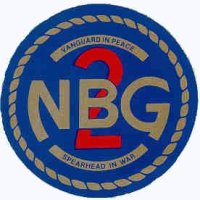The need for a single organization dedicated to the support of amphibious operations was recognized as a result of experience gained during the island-hopping campaigns of World War II. The decision to consolidate amphibious assault assets led to the establishment of NBG-2 in July 1948.
1990s
NBG-2 Detachments, composed of elements from the four subordinate commands, regularly embark aboard the ships of amphibious ready groups (ARGs) deployed to the Mediterranean Sea, the Indian Ocean, the Adriatic Sea, and throughout the Atlantic area from the coasts of Norway to South America to include the Caribbean Sea. From August 1990 through April 1991, detachments provided crucial support to amphibious forces for Liberia, Operation Sharp Edge; and Operations Desert Shield and Desert Storm in the war against Iraq.
From January to March 1991, approximately 800 active duty and US Naval Reserve personnel from NBG-2, its subordinate units, Navy Cargo Handling and Port Group, and Underwater Construction Team ONE deployed to the Persian Gulf as the MPF NSE in support of Operation Desert Storm. 100 Seabees of Amphibious Construction Battalion 2 departed Norfolk, Virginia, on amphibious ships bound for the Persian Gulf. While in the gulf these Seabees participated in numerous exercises with the Marines to prepare for an amphibious assault in the region. NBG-2 efforts directly contributed to the quick end of the conflict and were recognized by the awarding of the Navy Unit Commendation, the Southwest Asia Service Medal, and the Kuwait Liberation Medal (Saudi Arabia). Following the conflict, a NBG-2 Detachment remained behind in Jubail, Saudi Arabia, to assist in the backload and reconfiguration of MPF ships.
In August/September 1991, NBG-2 units participated in JLOTS III technology demonstrations off Fort Story, Virginia. Tests included conducting an actual cargo offload via LCAC and the Air Cushioned Vehicle Landing Platform (ACVLP). The Stern Adapter Unit (SAU) was installed on a Self-Propelled Causeway (CSP) and tested by flexing in to both the Navy and Army Roll-on/Roll-off Discharge Facilities (RRDFs) positioned at the head of the Elevated Causeway (ELCAS) System, up onto the ELCAS for rapid discharge of vehicles. This exercise also marked the first time ELCAS was deployed on a Seabee vessel and erected in-stream. The Seabee load-out included two LCU-1610s, four Side Loadable Warping Tugs (SLWTs), and the entire ELCAS System.
An NBG-2 Detachment in Pensacola was diverted from routine training operations in November 1991, to assist in the Haitian relief effort at Guantanamo Bay, Cuba. A detachment remained on-station to the end of 1991.
Throughout 1992, COMNAVBEACHGRU TWO and its units conducted routine training evolutions in support of MPF/JLOTS operations. During May, COMNAVBEACHGRU TWO units, as well as COMPHIBRON TWO, II MEF, and MPSRON ONE participated in Ocean Venture 92 Phase I, an MPF exercise conducted by USCINCLANT. Participants planned and executed MPF operations across Onslow Beach at Camp Lejeune, North Carolina. NBG-2, NAVCHAPGRU-2, II MEF, and NMCB-2 personnel offloaded equipment in support of ground operations. From July to September of that year, NAVBEACHGRU TWO participated in Ocean Venture 92 Phase II, a USCINCLANT directed joint exercise to test and evaluate the Offshore Petroleum Discharge System (OPDS). Testing was conducted offshore at Eglin AFB, Florida in support of the JLOTS III Joint Test and Evaluation Directorate. An average of 1,100 US gal (4,200 L; 920 imp gal) of fuel per minute, 10% greater than the operational requirements was pumped ashore. More than 2,400,000 US gal (9,100,000 L; 2,000,000 imp gal) of fuel was received by the Army Inland Petroleum Distribution System (IPDS) and the Marine Corps Amphibious Assault Fuel System (AAFS), with no fuel spills and involving the pumping of fuel from sea to shore, and was conduced environmentally safe. During September 1992, COMNAVBEACHGRU TWO units participated in the Hurricane Andrew Disaster Relief Efforts.
Routine exercises and deployments continued throughout 1993, 1994, and 1995. Ocean Venture 1993 Phase I (MPF) was conducted at Roosevelt Roads, Puerto Rico in May 1993; followed by Phase II (JLOTS) in June at Onslow Bay, Camp Lejeune, North Carolina. In 1995, NBG-2 saw the relocation and home porting of the COMPSRON ONE staff and PMSRON ONE ships to the SIXTHFLT AOR. Exercise Fuertas Defensas 95, in spite of a robust hurricane season and adverse weather conditions was conducted at Fort Story, Virginia, with great success. With the relocation of MPSRON ONE to the MED AOR.
The year 1996, saw three major exercises and Naval Support Element Trainings, in addition to real world contingency TWA Flight 800 salvage operations.
Two major exercises and in-theater Naval Support Element Training, in addition to another real world contingency to off load the motor vessel BOBO in Rota, Spain, was accomplished in 1997. NBG-2 saw the first-ever on load and offload of the ELCAS (M) on a T-ACS and the upload and download of Beach Group craft on a Seabee ship.
The year 1998 continued to be a banner one as Beach Group TWO conducted the remainder of the backload of the BOBO and contributed immensely to Baltic Challenge and Dynamic Mix in Iskenderun, Turkey. Since the Millennium, Naval Beach Group detachments have supported routine exercises and ARG deployments.

